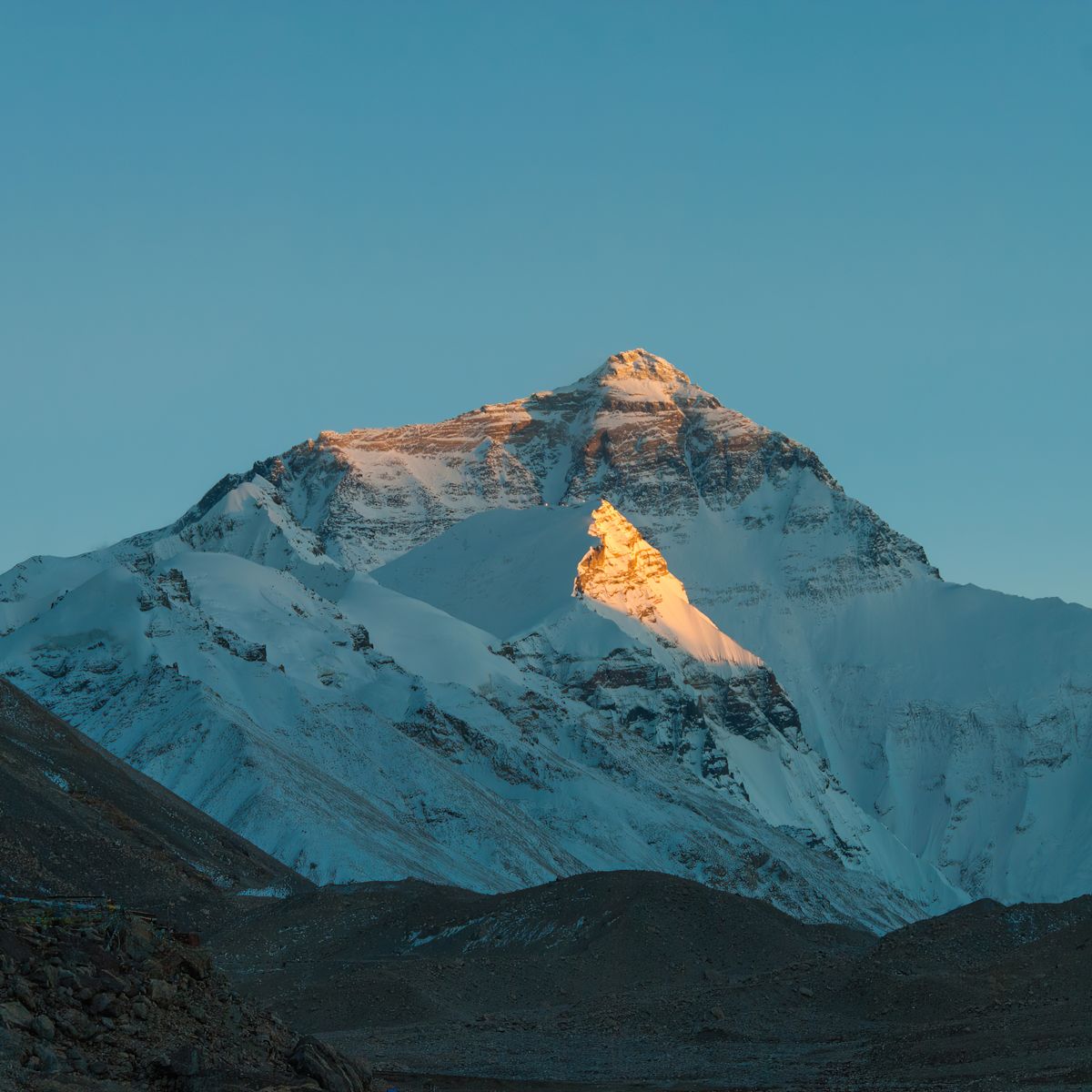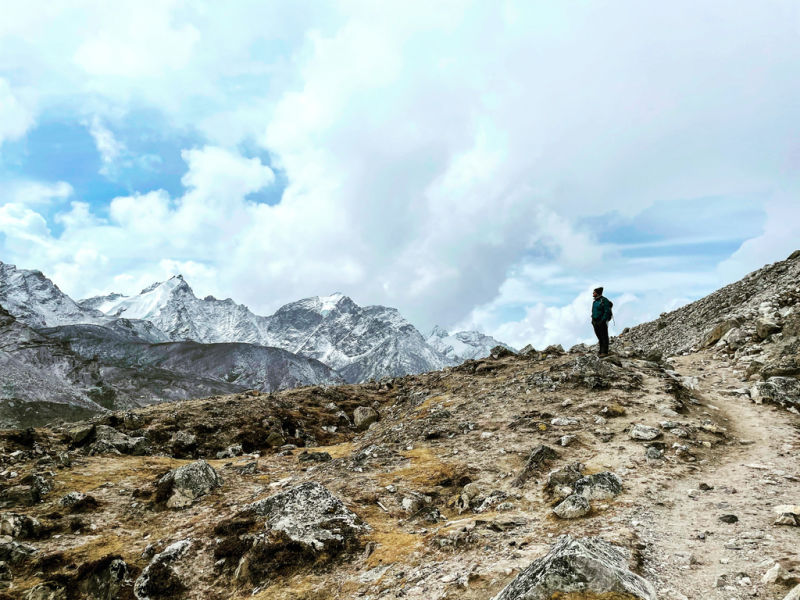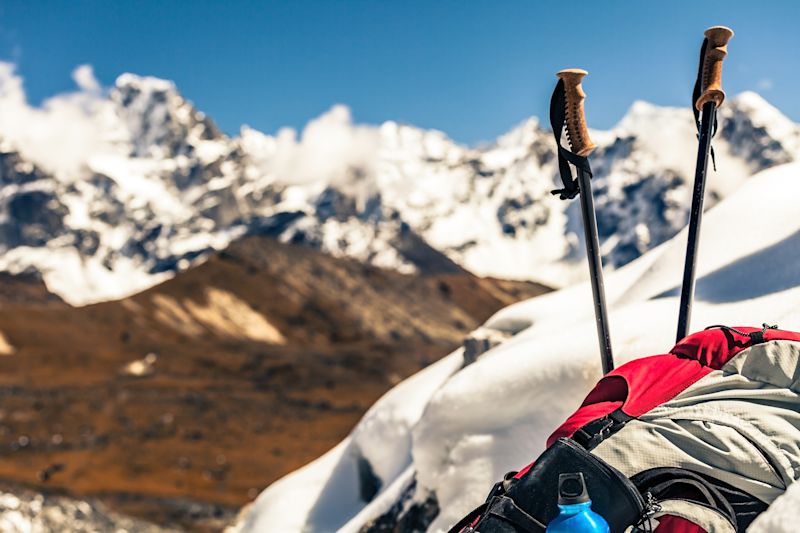The Everest dream
Have you ever dreamed of standing on top of the world? Climbing Mount Everest is the ultimate test of human endurance, pushing adventurers to their physical and mental limits. From the stunning views of the Himalayas to the feeling of accomplishment at the summit, Everest offers an experience unlike any other. But how long does it take to climb Mount Everest, and is the risk worth the reward?
The answer depends on various factors, from the route you take to how well you acclimatise. For individuals who possess the necessary skills and ambition to scale the world's highest peak, Everest expeditions demand a substantial financial commitment, frequently amounting to six figures.
For those seeking an alternative approach to exploring the Himalayas, the Everest Base Camp (EBC) trek offers an exciting and significantly more affordable option. It allows you to experience the region without the high costs or the need for mountaineering skills required.
So, whether you’re a seasoned climber or someone considering the trek to Base Camp, understanding the logistics of Everest will help you prepare for the adventure of a lifetime.
Ready to discover the truth behind this iconic expedition? Let’s dive in!
Understanding the climb
Overview of Mount Everest
Mount Everest isn’t just a mountain—it’s a 29,032-foot (8,849-meter) metaphor for human ambition. Straddling Nepal and Tibet, Everest’s summit is the ultimate prize for experienced mountaineers.
Before you start packing carabiners and energy gels, let’s break down the realities:
- First Ascent: Sir Edmund Hillary and Tenzing Norgay in 1953.
- Annual Climbers: Roughly 800-1,000 attempt the summit each year.
- Success Rate: ~65% (with experienced guides).
If you’re looking for a deep dive into everything Everest, click here.
Why climbing Everest is a challenge
Everest isn’t just about altitude. It’s a cocktail of logistics, weather, and sheer luck.
Here’s why:
1. Altitude Sickness: Above 26,000 feet (the “Death Zone”). At this point in the journey, your body starts to shut down due to low oxygen levels and the extreme cold.
2. Weather Windows: Summit attempts hinge on narrow May windows when the winds calm.
3. Khumbu Icefall: A shifting labyrinth of ice that claims lives yearly. Yet another reason why not just anyone can summit Everest and live to tell the tale.
Fun Fact: The average temperature on Everest is -19°C (-2°F), but wind chill can drop it to -60°C (-76°F). Brrr.
How many days would it take to climb Mount Everest?
Typical expedition duration
Forget “quick summits.” Most expeditions take 6–9 weeks, including acclimatisation and weather delays. In contrast, the EBC trek takes just 13 to 21 days, which offers a thrilling Himalayan adventure without the months-long commitment. This choice depends on how much time every individual climber can dedicate to the adventure.
The long expedition can be attributed to two main factors:
- Acclimatisation Rotations: 3–4 weeks (climbing up/down to adjust to altitude).
- Summit Push: 7–10 days (waiting for weather, final ascent).
With a few varying factors, here is a sample timeline of what to expect when climbing Everest:
Phase | Duration | Purpose |
Arrival in Kathmandu | 3–5 days | Gear checks, permits, briefings. |
Lukla to Base Camp | 8–12 days | Trekking + gradual altitude gain |
Acclimatisation | 14–21 days | Rotations to Camps 1–4 |
Summit push | 7–10 days | Weather-dependent final ascent |
Descent | 2–4 days | Return to Base Camp + trek to Lukla |
Breakdown of Climbing Days
- Base Camp to Camp 2: 2 days (crossing the Khumbu Icefall).
- Camp 2 to Camp 3: 1 day (ascending the Lhotse Face).
- Camp 3 to Camp 4: 1 day (traversing the Geneva Spur).
- Camp 4 to Summit: 1 grueling day (12–18 hours round-trip).
Pro Tip: Rushing acclimatisation = guaranteed failure (or worse). Remember that nature is ultimately always in control.
Hiking vs. climbing: Key differences
Hikers and climbers on Everest face different challenges in altitude, difficulty, skills, and risks. Hikers trek to Base Camp on established trails, battling altitude while still experiencing the beauty of the Himalayas. Climbers endure extreme cold, oxygen depletion, and life-threatening terrain, needing advanced mountaineering expertise to survive the summit attempt. For climbers, every step is a test of endurance, skill, and survival.
Climbing Everest is an elite pursuit, with the total cost of an expedition typically exceeding $100,000 when factoring in permits, guides, gear and logistics. The EBC trek, however, offers an affordable alternative to those who want to experience the beauty, thrill and majesty of Everest at a fraction of the cost.
So, to sum it up perfectly, if you’re an adventurous hiker with a reasonable level of fitness and a reasonable budget, the Everest Base Camp trek offers an exhilarating way to experience the Himalayas without the demands of high-altitude mountaineering. On the other hand, those aiming for the summit should be experienced climbers with the necessary skills, time, and wealth to take on one of the world’s most challenging expeditions.
Here’s what you need to know about the journey:
Aspect | Hiking (Everest Base Camp) | Climbing (Everest Summit) |
Duration | 12–21 days | 6–9 weeks |
Altitude | 17,598 ft (5,364 m) | 29,032 ft (8,849 m) |
Permits | TIMS card + Sagarmatha permit | $11,000+ climbing permit |
Cost (comprehensive package) | $1,000 – $4,000 | $30,000 - $100,000 |
Fitness level | Moderate | Extreme |
Typical hiking duration to Base Camp
The Everest Base Camp (EBC) Trek is a 12–21 day adventure through Sherpa villages, rhododendron forests, and suspension bridges that’ll test your fear of heights but also give you an experience you will cherish for the rest of your life.
Highlights:
- Lukla to Namche Bazaar: 2 days (hello, first views of Everest!).
- Namche to Dingboche: 3 days (acclimatisation hikes included).
- Dingboche to EBC: 2 days (passing memorials for fallen climbers).
Why Trekkers Love It: You get 90% of Everest’s awe with 10% of the risk.
Factors that influence climbing duration
Climbing Everest is not just about physical strength—it’s a complex interplay of environmental, logistical, and personal factors.
Here’s a detailed breakdown of what influences the duration of an Everest expedition:
1. Acclimatisation needs
Acclimatisation is the process of allowing your body to adapt to high altitudes, where oxygen levels are significantly lower. Rushing this process can lead to acute mountain sickness (AMS), high-altitude pulmonary edema (HAPE), or even death. At 26,000 feet, the air holds just a third of the oxygen you’d get at sea level. To survive, your body needs weeks to adapt.
Picture this: Climbers play a high-stakes game of “climb high, sleep low,” scaling icy slopes to Camp 3 one day, then retreating to Base Camp to recover. These rotations aren’t optional—they’re your lifeline. Skip them, and altitude sickness (think pounding headaches and fluid-filled lungs) becomes your worst enemy.
Key stages of acclimatisation:
- Base Camp (17,598 ft): Climbers spend 3–4 nights here to adjust.
- Camp 2 (21,000 ft): 2–3 nights, with short hikes to higher altitudes followed by returns to sleep lower (“climb high, sleep low”).
- Camp 3 (23,500 ft): 1–2 nights, focusing on short rotations to avoid overexertion.
Why it takes time:
- Physiological Changes: The body produces more red blood cells to carry oxygen, a process that takes weeks.
- Risk of AMS: Symptoms like headaches, nausea, and dizziness can escalate quickly without proper acclimatisation.
2. Weather conditions
Everest’s weather is notoriously unpredictable, with summit attempts possible only during narrow weather windows in May.
Key weather challenges:
- Jet Stream Winds: Winds can exceed 100 mph, making climbing impossible outside of calm periods.
- Temperature: Average temperatures range from -19°C (-2°F) to -60°C (-76°F) with wind chill.
- Storms: Sudden snowstorms can delay expeditions by days or weeks.
Impact on duration:
- Waiting Periods: Climbers often wait at Camp 4 (26,000 ft) for 7–10 days for a safe weather window.
- Aborted Attempts: In 2019, a cyclone in the Bay of Bengal forced climbers to abandon summit attempts for 5 days.
3. Climber’s experience level
Experience plays a significant role in determining how long an Everest expedition takes.
Beginners vs. experts:
- Beginners require more time for acclimatisation, training, and learning technical skills like using crampons and ice axes.
- Experts: Can move faster and make quicker decisions, reducing overall expedition time.
As an example of the significant difference between beginners and experts, look no further than Reinhold Messner. The legendary Italian mountaineer from South Tyrol summited Everest in 1980, alone and in just three days. He also completed this without supplemental oxygen—a feat only possible for elite climbers. Average climbers, however, typically take 6-9 weeks due to slower acclimatisation and reliance on guides. Even then, the summit feels nearly impossible which is why the EBC trek is such a popular choice for those unwilling to suffer the harsh reality of nature in its rawest form.
4. Support and logistics
The quality of support and logistics can make or break an Everest expedition.
Key factors:
- Guide Experience: Experienced guides can optimise acclimatisation schedules and weather windows.
- Sherpa Support: Sherpas carry gear, set up camps, and ensure safety, allowing climbers to focus on the climb.
- Equipment Quality: High-quality gear ( for example, oxygen systems, and down suits) reduces risks and delays.
Impact on duration:
- Efficient Teams: Well-organised expeditions with strong Sherpa support can complete the climb faster.
- Logistical Delays: Poorly planned expeditions may face delays due to equipment failures or inadequate supplies.
5. Physical fitness and health
Physical fitness and overall health are critical factors in determining how long an Everest expedition takes.
Key considerations:
- Cardiovascular Fitness: Climbers need exceptional endurance for long days of hiking and climbing.
- Strength Training: Strong legs and core are essential for carrying heavy packs and navigating technical terrain.
- Health Conditions: Pre-existing conditions like asthma or heart issues can complicate acclimatisation and prolong the climb.
Training timeline:
- 6–12 Months: Most climbers train for at least 6 months, focusing on cardio, strength, and altitude simulation.
- Altitude Training: Some climbers use hypoxic tents to simulate high-altitude conditions and reduce on-mountain acclimatisation time.
6. Route conditions
The condition of the climbing route can significantly impact expedition duration.
Key challenges:
- Khumbu Icefall: A dangerous section of shifting ice that requires careful navigation.
- Fixed Ropes: Delays can occur if ropes are not properly maintained or replaced.
- Crowds: Overcrowding on popular routes ( for example, the South Col route) can cause bottlenecks and delays.
The Summit push: How long does it take to summit Everest?
Final ascent overview
The summit push starts at Camp 4 (26,000 ft). Climbers leave at midnight to reach the top by morning, avoiding afternoon storms.
Timeline of summit day:
- Midnight: Depart Camp 4.
- 4 AM: Reach the Balcony (27,600 ft).
- 7 AM: Pass the South Summit (28,700 ft).
- 10 AM: Summit (29,032 ft).
- 1 PM: Return to Camp 4.
Reality Check: Only 50% of climbers make it past the Hillary Step on their first try.
Pre-climb preparation and planning
When gearing up for an Everest climb, your body must be prepared for some serious challenges. It’s not just about hitting the gym—your training should cover everything from endurance to flexibility.
Think about incorporating:
- Cardio: Go for runs or long hikes to boost heart and lung capacity.
- Strength: Squats, lunges, and deadlifts work wonders for your legs, core, and upper body.
- Stamina: Tackle extended hikes with a weighted pack to build endurance.
- Altitude Adaptation: Train at high altitudes or use simulators to get used to low-oxygen conditions.
- Flexibility: Stretching or yoga can keep you agile and injury-free.
While your body prepares, don’t overlook your mindset. A strong mental attitude is crucial—stay calm, focused, and ready for unexpected challenges. A clear head and steady determination can turn daunting moments into stepping stones on your journey to the summit.
Gear and equipment for climbing Mount Everest
Having the right gear isn’t just helpful—it’s essential for survival. Every item you bring must withstand extreme cold, harsh winds, and the unpredictable terrains of Everest. The right equipment can be the difference between success and serious risk. Rent gear in Kathmandu to save money or invest in your own if you plan to undertake multiple high-altitude expeditions. Just remember to keep UIAA safety standards in mind when making that purchase.
Clothing & outerwear
- Base Layers: Moisture-wicking materials like merino wool keep sweat off your skin.
- Insulated Jacket: A thick down or synthetic jacket is critical for warmth in freezing conditions.
- Waterproof & Windproof Shell: Guards against snow, wind, and fast-changing weather.
- Gloves & Mittens: Layered hand protection for warmth and mobility.
- Climbing Pants: Windproof, waterproof, and flexible enough to move in.
Footwear
- Mountaineering Boots: Insulated high-altitude boots keep feet warm and provide traction.
- Gaiters: Keep snow, ice, and debris out of boots.
- Layered Socks: A moisture-wicking liner with thick insulation keeps feet dry and warm.
Climbing equipment
- Crampons: metal spikes for traction on ice and snow. 12-point steel for Icefall traction is recommended.
- Ice Axe: Crucial for balance, 65–75 cm for glacier travel.
- Climbing Harness: Keeps you secured when using ropes on tricky sections.
- Ropes: Used in all safety and navigation through difficult terrain.
Safety & navigation
- Helmet: Protection from falling ice and rock debris.
- Headlamp: A must for early-morning or nighttime ascents.
- Oxygen Mask & Regulator: Needed for life above 8,000 meters. Oxygen cylinders, a regulator, and a mask for a summit-grade setup.
- GPS & Satellite Phone: Aids navigation and emergency contact.
Hydration, Nutrition & Essentials
- Hydration System: A water bladder or insulated bottle to prevent dehydration.
- High-Calorie Snacks: Lightweight, energy-packed foods keep you fueled.
- First Aid Kit: Includes altitude sickness medication, pain relief, and wound care.
- Sunscreen & Lip Balm: Protects against the intense high-altitude sun.
- Camera (Optional): A lightweight little camera catches all those moments you want to remember forever.
If the thought of carrying such extensive gear for an Everest Summit feels daunting, you might find the trek to Base Camp a more manageable alternative. For a lighter, yet equally rewarding experience, explore this carefully curated packing list for the essentials you’ll need on the trek to Base Camp.
The environmental impact of Everest expeditions
Climbing Everest is a dream for many, but it comes with a significant environmental cost. As the number of climbers increases, so does the waste and pollution left behind on the mountain. It's estimated that over 50 tons of garbage are left each year, including discarded gear, oxygen tanks, and even human waste. The demand for firewood also leads to deforestation in nearby areas, while flights and helicopters contribute to carbon emissions. Local wildlife, such as the snow leopard, is also increasingly impacted as human activity disrupts their natural habitats.
If you're ready to summit Everest without adding to the problem, here are a few things you can do:
- Take everything with you: Don't leave behind any waste—pack out everything, even your human waste.
- Pick eco-friendly operators: Go with trekking companies that prioritise environmental responsibility and proper waste disposal.
- Limit your gear: Only bring what’s necessary to reduce unnecessary waste.
- Offset your carbon emissions: Contribute to programs that balance out the emissions caused by your travel.
- Educate fellow climbers: Spread awareness on how to protect Everest's fragile environment for future generations.
Mount Everest is a global treasure facing the Peril of Pollution and overcrowding. Remember that every step leaves a footprint and future generations will appreciate its preservation.
Everest without the ice axe
Let’s be honest—climbing Mount Everest is incredibly dangerous, expensive, and requires months (if not years) of training. Those who are committed to this challenge will have a life-changing experience; however, not everyone will be able to safely and successfully complete the climb. The good news? You don’t have to risk frostbite, bankruptcy and oxygen deprivation to experience the magic of the Himalayas. Trekking to Everest Base Camp (EBC) offers jaw-dropping scenery, cultural richness, and a serious physical challenge—minus the life-threatening risks.
Why Everest Base Camp just makes more sense:
- No Technical Climbing Needed: Forget ropes, crampons, and ice axes. If you can handle long hikes and altitude, you can make it to Base Camp. It’s tough, but it’s a trek, not a climb.
- Altitude Without the Extreme Risk: Everest’s summit is in the “Death Zone,” where oxygen is scarce and bad decisions are common. The EBC trek allows your body to acclimate gradually, making the experience much safer.
- Comfort Along the Way: No tents on sheer cliffs. The well-marked path to Base Camp is lined with tea houses offering warm meals, cozy beds, and even Wi-Fi (for those who need to post their adventure in real-time).
- Views Just as Stunning: At Base Camp, you still get awe-inspiring views of Everest, Lhotse, and Nuptse, without the exhaustion of a summit push. (The fresh, crisp air is a major plus, making everything just seem more magical.)
- A Cultural Experience: The trek winds through Sherpa villages, Buddhist monasteries, and the bustling Namche Bazaar. You’ll soak in traditions, sip butter tea, and maybe even pick up a few Nepali phrases.
- Low-cost, High-value: The current economy shouldn’t hold anyone back from experiences that will make them feel alive. The EBC trek offers you everything you need while ensuring that you don’t break the bank.
At the end of the day, the Base Camp Trek lets you experience Everest’s beauty without the extreme danger. It’s an adventure, a test of endurance, and a journey through one of the most stunning places on Earth. For more information about this amazing experience, look into things you need to know before doing the Everest Base Camp trek.
Planning your Everest expedition
Climbing Mount Everest is more than a physical journey—it’s a test of patience, preparation, and respect for the mountain’s raw power. Whether you’re drawn to the summit’s icy crown or the cultural richness of the Base Camp trek, the Himalayas demand careful planning and humility. Now that you know the timeline, challenges, and gear required, what’s next?
If Everest’s call feels impossible to ignore, start small:
- Talk to survivors (yes, climbers who’ve made it back). Their unfiltered stories—frostbitten toes, sleepless nights at Camp 4—will either fuel your fire or save your life.
- Test your limits on lesser peaks and train well.
- Save relentlessly—permits, gear, and guides cost more than most cars.
Or, ditch the ice axe and join the 99% who find Everest’s magic below the Death Zone. The Base Camp trek still serves adrenaline with a side of momos and milky tea—no Sherpa-guided rope tricks required.
Whichever path you pick, remember: Everest isn’t going anywhere. Train hard, pack smart, and decide if you’re chasing a summit or a story. When you’re ready, the mountain will still be there… waiting.






